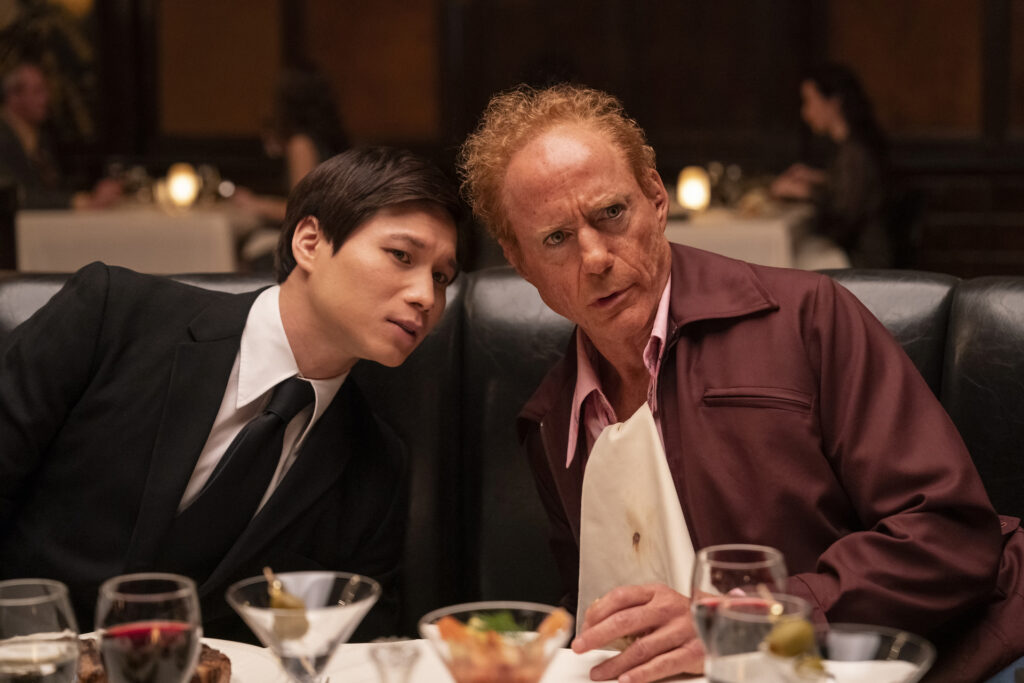
SUMMONING CREATIVE VFX TO HEIGHTEN REALITY IN THE SYMPATHIZER
www.vfxvoice.com
By TREVOR HOGGImages courtesy of HBO.Given the dark, satirical nature of the Pulitzer Prize-winning novel by Viet Thanh Nguyen, where a police captain in Saigon who is a communist spy comes to America as a refugee at the end of the Vietnam War, Park Chan-wook was an ideal choice as a co-showrunner, director and writer to create a seven-episode adaptation of The Sympathizer for HBO.Split screens and table markers were critical parts that enabled the Captain to interact with his four dinner companions played by Robert Downey Jr.Park has a reputation for redefining genres, whether it is the vengeful Oldboy or psychological thriller The Handmaiden. Creatively, there are so much going on with him, notes Visual Effects Supervisor Chad Wanstreet (Dollface, S.W.A.T.). Director Park storyboards almost everything, and what isnt storyboarded he still comes with a specific shot list every day. There is very little deviation from that. Every once and awhile hell cut one and add something different.After we see Bons legs running down an airport runway while carrying his dead wife, the scene transitions into the Captains car driving on an American highway. At this moment, Bons legs are still visible as a reflection on the car body. This is a scene transition that brilliantly connects two timelines/two countries through the visual connection of running objects. The idea to show Bons legs on the car was entirely from Chad. Its not often that the visual effects team spontaneously brings new ideas, as it is hard enough to fulfill requests of the director. However, Chad has done so for this scene and many others.Park Chan-wook. DirectorThe Congressman portrayed by Robert Downey Jr. was partially inspired by Ronald Reagan.Visual effects are seen as way of elevating the dramatic or comedic aspect of a scene. There is a lot of punctuation, and he uses visual effects in that way to either set up a scene or environment, Wanstreet notes. We had lots of flies and rats, different small creatures that normally are throwaways, but he uses them in a manner to heighten the reality of whatever scene that youre in. We had one shot where the Captain and the General are in the latrine talking back and forth, and flies everywhere. The General is irritated; a fly comes in, lands on his cheek and then flies off. There are tons of subtlety and little things that director Park does where most people wouldnt think, Lets do a visual effects fly for comedy relief in this tense situation. But he is constantly doing these things that are contradictory to what is being established.Atmospherics, such as enhancing cigarette smoke, were important. There were moments where we matched cut one person blowing out smoke to another blowing out smoke, Wanstreet reveals. There is one where Sofia Mori is in the Vietnamese restaurant and Captain is outside talking to Bon. We transition from Sofia blowing out smoke to then Captain match cut blowing out the exact same level of smoke; these specific details where color and amount [of smoke] director Park wants them to match back and forth. Later, when Sofia Moi and Captain are lying in bed together and are smoking together, he wanted to have exact same cigarette smoke across the two of them so theres enhancement of cigarette smoke in there to make everything exact between the two.The rotating Happy Burger sign was achieved practically.Scene transitions are meticulously planned with a particular one standing out. After we see Bons legs running down an airport runway while carrying his dead wife, the scene transitions into the Captains car driving on an American highway, Park explains. At this moment, Bons legs are still visible as a reflection on the car body. This is a scene transition that brilliantly connects two timelines/two countries through the visual connection of running objects. The idea to show Bons legs on the car was entirely from Chad. Its not often that the visual effects team spontaneously brings new ideas, as it ishard enough to fulfill requests of the director. However, Chad has done so for this scene and many others.There is a lot of punctuation, and [directpr Park] uses visual effects in that way to either set up a scene or environment. We had lots of flies and rats, different small creatures that normally are throwaways, but he uses them in a manner to heighten the reality of whatever scene that youre in.Chad Wanstreet, Visual Effects SupervisorMany skies were digitally augmented to match the photographic vision of director Park Chan-wook.Digital assistance was provided to some of the scene transitions, such as when Captain is crossing names off of the evacuation list. We definitely helped out with that, Wanstreet notes. As you know, director Park is specific as far as lines being in parallel or how they converge. Composition is important to him. We took the footage and skewed it, realigned it and did some stuff to make it lay out better on the page. There is a little bit of elements to that ruler that are also visual effects. When Captain pulls it across, that wipe, were carrying that and roto his hand so as it comes in the background its there, but then the hand brings the rest of it in. That was one of the things he and I worked back and forth on to get that exactly the way he wanted because it was funky in the beginning.Fireworks proved to be complicated to execute. This is one of those [situations] where a lot of people go into a scene like that [and say], Were going to put fireworks in the sky, Wanstreet remarks. But director Park wanted the texture of the fireworks reflecting all throughout that scene, which is visually amazing, but you can imagine from budgetary standpoint, were like, Okay. We had big practical lights on the night. Those were great for interactive lights on the people and in some of the environments, but then they made nasty reflections on some of the metallics and the wet-down. We had to paint all of that out and then add fireworks reflections back in, so it was more organic and broken up. But at least we had something to start with. We took whatever was going on in the panels in the sky, then matched our colors of our fireworks to those so we had a match between practical interactive light and visual effects firework.A personal favorite of Visual Effect Supervisor Chad Wanstreet was the theater explosion.Having Robert Downey Jr. playing the roles of the priest, auteur. Claude (CIA agent), professor and Congressman harkens back to when Peter Sellers portrayed three characters in Dr. Strangelove or: How I Learned to Stop Worrying and Love the Bomb. The team that came on to do the makeup had done Perry Mason previously, and we had an excellent prosthetic artist as well, Wanstreet explains. They were upfront when they thought there would be an issue, and we went in touched stuff up, but for the most part what you see is what they did. Robert in the steakhouse and lounge were thoroughly planned-out scenes because getting him into prosthetics took three hours for each one of the characters, depending on which character it was. In order to shoot that, we wound up breaking it into multiple days; there were two Roberts on one day and two Roberts on the next day. He would do all of his lines, and we had markers all over the table for where cameras were, so we could replay how we shot one for when the next one came in. When Robert went away to do the prosthetics for another character, we would film backgrounds, like crosses of waiters from the different camera angles. so when we did the split screens, there was always movement in the background.We had one shot where the Captain and the General are in the latrine talking back and forth, and flies everywhere. The General is irritated; a fly comes in, lands on his cheek and then flies off. There are tons of subtlety and little things that director Park does where most people wouldnt think, Lets do a visual effects fly for comedy relief in this tense situation. But he is constantly doing these things that are contradictory to what is being established.Chad Wanstreet, Visual Effects SupervisorBuildings had to be altered and removed in order to recreate Saigon in 1975.When the time came to shoot the lounge scene, face replacements were necessary, which led to some unique challenges. When we were scanning Robert, it came down from director Park that he wanted the Congressman to lick whipped cream off this escort with a face replacement, Wanstreet recalls. Because were doing FACS and all sorts of expressions, I go, Alright Robert, I have one more expression for you. I need you to give me a face like youre going to lick whipped cream off of a naked womans breasts. He looked at me as if to say, What? I said, Trust me. Youre going to lick whipped cream off of this woman. Robert sits there for a second and goes, Alright. Ive got it. He makes this crazy expression, we scanned him, and he goes, Ive got a different one. We did that one as well. Then Robert comes out, and I go, Youre probably one of the most scanned actors in the world. Have you ever had to pose for licking whipped cream off of a naked woman? He goes, No. Youve got the first, Chad.A personal first for Wanstreet involved a certain cactus. Because director Park has this specific visual style, there were a lot of little things that popped up all over the place, Wanstreet explains. After Xuande gets blown up in Episode 105, he brought a cactus, and there was a line about a prickly dick. The cactus that we had on set wasnt cactus enough and didnt have the right needles; that became a thing. It was like, Wait a minute. What? We had to add more needles to this cactus, which is something Ive never had to do before. Another fun shot featured an alligator in a swimming pool. We had a remote-control alligator head on the day to give an eyeline for Robert. We would rehearse and take it away. Robert did wonderfully, as far as acting as if theres an alligator in the water when there clearly is not. Those were complicated shots. Just getting the right number of bubbles and the cavitation correct.Modern elements like electronic billboards had to be removed to make the imagery period accurate.Robert [Downey Jr.] in the steakhouse and lounge were thoroughly planned out scenes because getting him into prosthetics took three hours for each one of the characters, depending on which character it was. We wound up breaking it into multiple days; there were two Roberts on one day and two Roberts on the next day. He would do all of his lines, and we had markers all over the table for where cameras were, so we could replay how we shot one for when the next one came in.Chad Wanstreet, Visual Effects SupervisorLocations were the primary focus. We filmed in Los Angeles, and when we went to Thailand it was all location shooting, Wanstreet states. We did one day of bluescreen, and thats where we have Xuande going through the air. We had found a little road in Phuket that looked more French and had similar tones of what you might see in Vietnam. We spent about a month and a half going in and around the Bangkok area, then ended up in Phuket, Phang Nga, Nakhon Si Thammarat and Ban Phai. We were moving all around the country for bespoke one-off spots that we would augment with visual effects in post by adding monuments and things that were particular to that time. In Episode 101, when they do the farewell tour and drive through downtown Saigon, specific landmarks were wanted. Theres the opera house, ARVN monument and palace. I had gone to Vietnam and taken some photography, but all of those buildings had changed a ton since current day and 1975.Bluescreens were pivotal in being able to achieve the desired environmental scope.Around 1,200 visual effects shots were created for the miniseries, with the main vendors being Ingenuity Studios and Barnstorm VFX, along with Zoic Studios, Yannix, Incessant Rain Studios, BOT VFX, Mr. Wolf, Van Dyke VFX and Pidantic VFX. I work differently than a lot of people in that I have all of my shots pre-tracked on my show, Wanstreet says. Yannix did all tracking and touched almost everything in every episode. We handed that off to whoever the vendor was and also did paintwork. There are lot of shots where one person is painting or tracking, and then somebody else is adding maybe the set extension. There were also elements like the flares that we were passing back and forth because thats something that showed up a lot and was a thematic element that was in Episode 101, and we see it again in Episode 107, tying those two anchor points in those episodes. The helicopter was also a shared asset that moved around with different vendors; the same thing with the jet.For safety and art direction reasons, explosions close to the actors were achieved digitally.Elaborate re-timed split screens were incorporated into a couple of the 4,000 frame shots. They dont sound gnarly, but one of them in particular was when we filmed in the interrogation room where the Watchman was and there were metal grates all over the place, Wanstreet recalls. When you start to do a re-time in a room like that, it warbles and distorts like crazy. We cleaned up all that stuff over 4,000 frames, and there was some stuff on the floor that we needed to remove. There were reflections of the camera guy and Kim Ji-yong [Cinematographer] in the glass; over 4,000 frames, youre removing him over Roberts face. Were painting all of that out and trying to keep all of the metal grates exactly in line. Lens aberrations were important. Obviously, if youre nighttime and an explosion goes off, as a DP you have two decisions: You can try to expose for the fire or your talent. We were constantly playing with getting this perfect blend where we would see the fire detail for a moment and our actors would go out and everything is black. You would get flares and then pull back so youre seeing the talent again, and the explosions goes out and theyre brighter.It was impossible to wet down the entire tarmac, so the responsibility was given to the visual effects team.The actual filming had to be done with a fake airplane that only had the tail reproduced of the C-130.The most complex visual effects sequence was the tarmac escape, which occurs in Episode 101.Insects are an essential part of the visual language of director Park Chan-wook.Getting the proper reflections for the fireworks was a complex task.A remote-control alligator head was replaced by a CG version created by Ingenuity Studios.As for the experience of collaborating with Park Chan-wook and Robert Downey Jr., Wanstreet remarks, Working with director Park and Team Downey, who have a clear vision, you could imagine that there is this potential for a clash. Thats not what happened at all. Team Downey loved director Park and gave him a lot of latitude to do what he wanted to do. The two of them worked hand-in-hand. When it comes to naming his favorite moments, Wanstreet answers, I love the explosion of the theater and the finale as well. The ocean at the end is pretty and beautiful. There is a lot of stuff that is great in Episode 107. When the Captain releases the alligator into the auteurs pool is wonderful work.Practical explosions were incorporated into digital ones.Chad Wanstreet and the entire Sympathizer team are saddened by the passing of friend and colleague Dan Lombardo. Wanstreet remarks, Dan was an exceptional friend and a bright beacon on the VFX team for the show. His loving disposition and kind heart always made even the hardest days enjoyable and his dedication to the team was infectious. Dans hilarious stories about his many years in the VFX industry will be missed, and we will all proudly cherish working with him.Watch dramatic VFX breakdown reels on the making of The Sympathizer from Ingenuity Studios and Chad Wanstreet, Click here: https://vimeo.com/949982071/ff40298c9a?share=copy. And here: https://vimeo.com/946362668
0 Commentarii
·0 Distribuiri
·392 Views


